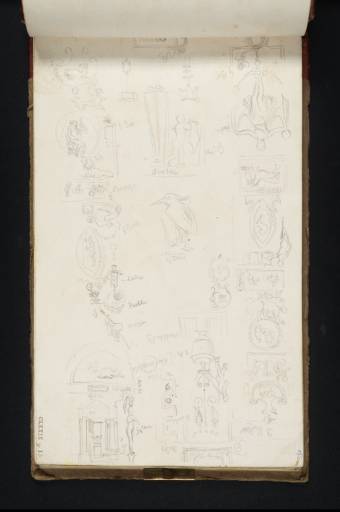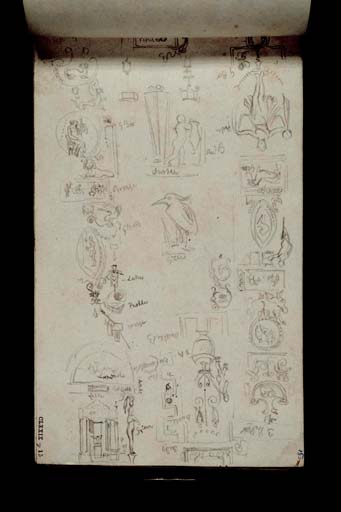Joseph Mallord William Turner Details of the Decorations of Raphael's Loggia in the Vatican: the Second External Pier 1819
Image 1 of 2
Joseph Mallord William Turner,
Details of the Decorations of Raphael's Loggia in the Vatican: the Second External Pier
1819
Joseph Mallord William Turner 1775–1851
Folio 15 Recto:
Details of the Decorations of Raphael’s Loggia in the Vatican: the Second External Pier 1819
D14957
Turner Bequest CLXXIX 15
Turner Bequest CLXXIX 15
Pencil on white wove paper, 186 x 112 mm
Inscribed by the artist in pencil with various notes on the loggia decorations [see main catalogue entry]
Inscribed by ?John Ruskin in blue ink ‘15’ bottom right, descending right-hand edge
Stamped in black ‘CLXXIX 15’ bottom left, descending left-hand edge
Inscribed by the artist in pencil with various notes on the loggia decorations [see main catalogue entry]
Inscribed by ?John Ruskin in blue ink ‘15’ bottom right, descending right-hand edge
Stamped in black ‘CLXXIX 15’ bottom left, descending left-hand edge
Accepted by the nation as part of the Turner Bequest 1856
References
1909
A.J. Finberg, A Complete Inventory of the Drawings of the Turner Bequest, London 1909, vol.I, p.527 as ‘Details of the decorations of the Logge, with descriptions of colour, &c.’.
1965
Jerrold Ziff, ‘Copies of Claude’s Paintings in the Sketch Books of J.M.W. Turner, Gazette des beaux-arts, vol.65, January 1965, pp.56, 64 note 24.
1974
Martin Butlin, Andrew Wilton and John Gage, Turner 1775–1851, exhibition catalogue, Royal Academy, London 1974, p.92 under no.236.
1979
Andrew Wilton, The Life and Work of J.M.W. Turner, Fribourg 1979, p.147.
1982
Evelyn Joll and Martin Butlin, L’opera completa di Turner 1793–1829, Classici dell’arte, Milan 1982, p.107 under no.228.
1982
Cecilia Powell, ‘Exhibition Review: Turner’s First Visit to Italy in 1819’, Turner Studies, Summer 1982, vol.2, no.1, p.48.
1984
Martin Butlin and Evelyn Joll, The Paintings of J.M.W. Turner, revised ed., New Haven and London 1984, p.137 under no.228.
1984
Cecilia Powell, ‘Turner on Classic Ground: His Visits to Central and Southern Italy and Related Paintings and Drawings’, unpublished Ph.D thesis, Courtauld Institute of Art, University of London 1984, pp.148, 151 note 2, 235.
1987
Robert E. McVaugh, ‘Turner and Rome, Raphael and the Fornarina’, Studies in Romanticism, no.26, Autumn 1987, pp.371–2.
1987
Cecilia Powell, Turner in the South: Rome, Naples, Florence, New Haven and London 1987, p.65 note 1.
1997
James Hamilton, Turner: A Life, London 1997, p.205 note 1.
1998
James Hamilton, Turner and the Scientists, exhibition catalogue, Tate Gallery, London 1998, p.68.
2009
Ian Warrell, ‘Painters Painted: The Cult of the Artist’, in David Solkin (ed.), Turner and the Masters, exhibition catalogue, Tate Britain, London 2009, p.229 note 1 under no.63.
2010
David Solkin and Guillaume Faroult (eds.), Turner et ses peintres, exhibition catalogue, Galeries nationales, Grand Palais, Paris 2010, pp.196, 262 note 12.
2011
Nicola Moorby, ‘Turner’s Sketches for “Rome from the Vatican”: Some Recent Discoveries’, Turner Society News, no.115, Spring 2011, pp.5, 10 notes 16 and 20.
One of the most significant series of studies dating from Turner’s 1819 trip to Rome was the sequence of on-the-spot pencil sketches relating to the Loggia of Raphael, a colonnaded porch on the second floor of the Vatican’s Apostolic Palace, decorated by Raphael (1483–1520) and his studio. The sixteenth-century loggia, which looks out over the Cortile San Damaso and St Peter’s Square, is approximately 65 metres long and 4 metres wide (215 by 13 feet) and comprised of thirteen bays. Each of the square vaults of the ceiling contains four frescoes of Biblical scenes, popularly known as ‘Raphael’s Bible’, illustrating Old and New Testament scenes from the Creation to the Last Supper. Meanwhile, the spandrels, lunettes, walls, pilasters and window piers are covered with stuccowork and painted grotesque decorations, ornamental arabesque patterns interspersed with human and animal figures, modelled after ancient Roman wall paintings such as those in Nero’s Domus Aurea on the Palatine Hill in Rome. The loggia was originally open to the elements causing the gradual deterioration of the frescoes, but in 1816 the windows had been glazed, a fact which is not obviously apparent within Turner’s sketches. Several scholars have argued that his interest in the loggia may have been prompted by contemporary British anxieties regarding the poor condition of the frescoes.1
Turner made a closely detailed visual record of the loggia, particularly concentrating on the southern end of the interior and the decoration of the first three bays and window arches, see folios 13 verso–21 (D14955–D14965). From these drawings evolved the artist’s first finished oil painting following his Italian tour, the vast canvas Rome from the Vatican. Raffaelle Accompanied by La Fornarina, Preparing his Pictures for the Decoration of the Loggia exhibited 1820 (Tate, N00503).2 It has been widely suggested that Turner thought of the idea for the picture whilst he himself was actually sketching there.3 However, the precise nature of these studies, focusing almost exclusively on the first three bays of the loggia, strongly suggests that in fact the artist had already conceived the theme before commencing his sketching campaign and was specifically gathering material with the concept already well advanced in his mind. Virtually every element recorded within his drawings was employed within the composition of the finished painting, and there are no sketches extraneous to this purpose. As Cecilia Powell has discussed, Turner was also able to cross-reference his on-the-spot sketches with detailed engravings of Raphael’s loggia which he borrowed from the Royal Academy during the later stages of the painting’s development in April 1820.4
The sketches on this page relate to his painted recreation of the loggia on the right-hand side of Rome from the Vatican. They depict the fresco and stucco decorations on the second external pier of the loggia (i.e. the pillar between the first and second windows from the end) and comprise three distinct groups, from top left to bottom right:
a.
The sketches in the top left-hand corner and top centre represents details of the stucco and grotesque decorations from the lateral side (northern or right-hand side as you face the interior wall) of the second external pier.5 On the left is the upper section of the pilaster which contains stucco medallions including, from top to bottom: a centaur with a trumpet; Jove; fighting Amazons seated on horses; and the figure of an artist working in the Loggia. Before the windows were enclosed with glass the fresco details suffered damage from exposure to the elements and are now much faded. The drawing continues at the top of the page on the right with the lower part of the pilaster.6 Turner has annotated the study with various colour notes including, from the top to the bottom of the pilaster: ‘G Bor’, ‘Bronze’, ‘G Balls’, ‘Lake’, ‘Purple’, ‘Orange’, ‘Landscape’, ‘Red Wall’, ‘Lilac’, ‘ov’, ‘Green’, ‘P | W’, ‘P’, ‘violet’, ‘purple’ and ‘Red B’.
b.
The central sketch depicts a bird, inscribed ‘Green’, a detail from the base of the pilaster.
c.
The final group of sketches is inverted at the bottom centre and right-hand side of the page. They represent details of the stucco and grotesque decorations of the facing (front) side of the second external pilaster.7 Turner has executed a record of the upper part along the full length of the page and then continued the drawing with the lower section beside it. The sketch is variously inscribed, from the top to the bottom of the pilaster: ‘3 the Pier’, ‘Green’, ‘Purple’, ‘G Bor’, ‘Dado solid’, ‘Dado’, ‘Purple’, ‘Red with | Blue | candelabra’, ‘D B’ and ‘Purple B’.
The sketches in the top left-hand corner and top centre represents details of the stucco and grotesque decorations from the lateral side (northern or right-hand side as you face the interior wall) of the second external pier.5 On the left is the upper section of the pilaster which contains stucco medallions including, from top to bottom: a centaur with a trumpet; Jove; fighting Amazons seated on horses; and the figure of an artist working in the Loggia. Before the windows were enclosed with glass the fresco details suffered damage from exposure to the elements and are now much faded. The drawing continues at the top of the page on the right with the lower part of the pilaster.6 Turner has annotated the study with various colour notes including, from the top to the bottom of the pilaster: ‘G Bor’, ‘Bronze’, ‘G Balls’, ‘Lake’, ‘Purple’, ‘Orange’, ‘Landscape’, ‘Red Wall’, ‘Lilac’, ‘ov’, ‘Green’, ‘P | W’, ‘P’, ‘violet’, ‘purple’ and ‘Red B’.
b.
The central sketch depicts a bird, inscribed ‘Green’, a detail from the base of the pilaster.
c.
The final group of sketches is inverted at the bottom centre and right-hand side of the page. They represent details of the stucco and grotesque decorations of the facing (front) side of the second external pilaster.7 Turner has executed a record of the upper part along the full length of the page and then continued the drawing with the lower section beside it. The sketch is variously inscribed, from the top to the bottom of the pilaster: ‘3 the Pier’, ‘Green’, ‘Purple’, ‘G Bor’, ‘Dado solid’, ‘Dado’, ‘Purple’, ‘Red with | Blue | candelabra’, ‘D B’ and ‘Purple B’.
Further studies related to the evolution of Rome from the Vatican can be found on folios 21 verso and 25–26 (D14966 and D14970–D14972), as well as an elaborate compositional drawing in pen and ink in the Rome C. Studies sketchbook (Tate D16368; Turner Bequest CLXXXIX 41).
Nicola Moorby
January 2010
See for example Powell 1987, p.116 and James Hamilton, Nicola Moorby, Christopher Baker and others, Turner & Italy, exhibition catalogue, National Galleries of Scotland, Edinburgh 2009, pp.52–3.
Martin Butlin and Evelyn Joll, The Paintings of J.M.W. Turner, revised ed., New Haven and London 1984, no.228.
See Powell 1987, pp.62 and 116–17, and Hamilton et al. 2009, p.53. Hamilton, for example, has described the studies as ‘far more detailed than [Turner] would reasonably need if he were not sympathetic to, and even complicit in, a complete copying of them’ and has stated that the artist only ‘used a fraction’ of them.
See Cecilia Powell, ‘On the Wing through Space and Time: The Dynamics of Turner’s Italy’, in Forum for Modern Language Studies, vol.39, no.2, April 2003, pp.199–200.
See Nicole Dacos, Le Logge di Rafaello: Maestro e bottega di fronte all’antico, Rome 1977, p.264, reproduced Tav.CI as ‘a) Pilastro II.B, esterno’ and Tav.XCV, as ‘b) Pilastro II.B, esterno. Stato attuale’. The design is repeated on the opposite side of the window.
Visible in a painting by Giovanni Ottaviani and Giovanni Volpato, reproduced in colour in Giorgio Marini, Nicole Dacos, Michel Hochmann, Annie Gilet et al., Giovanni Volpato: Les Loges de Raphaël et la Galerie du Palais Farnèse, exhibition catalogue, Musée des Beaux-Arts de Tours 2007, no.1a, p.125, as ‘Vue en perspective des Loges’ or ‘Frontispiece’.
How to cite
Nicola Moorby, ‘Details of the Decorations of Raphael’s Loggia in the Vatican: the Second External Pier 1819 by Joseph Mallord William Turner’, catalogue entry, January 2010, in David Blayney Brown (ed.), J.M.W. Turner: Sketchbooks, Drawings and Watercolours, Tate Research Publication, December 2012, https://www


